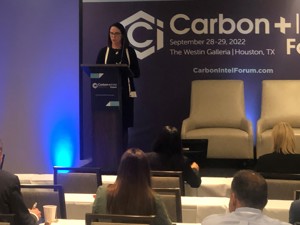Transportation and carbon management: The U.S. DOE takes the stage at the Carbon+Intel Forum
Carbon capture, utilization and storage (CCUS) projects have seen rapid growth in recent years, with the U.S. and Canada leading the wave and Europe not far behind. Gulf Energy Information’s Carbon+Intel Forum in Houston, Texas, brought out global experts in CCUS to discuss methods of reducing and eliminating carbon emissions. On day 1, Traci Rodosta, Storage and Testing Infrastructure Program Manager for the U.S. Department of Energy Office of Fossil Energy (DOE-FE), delivered a keynote titled, “Addressing key gaps on the critical path towards carbon capture and storage (CCS) deployment.”
Carbon management provisions. Rodosta began her presentation with a reminder that the DOE-FE is now the DOE Office of Fossil Energy and Carbon Management (DOE-FECM). The name change was made to reflect the updated vision of the DOE-FECM (net-zero emissions by 2050). Achieving this goal will require many CCUS facilities across the U.S. and a reduction of billions of metric t.
“If you think of 1-MM metric t, let’s think of 1-MM seconds. For 1-MM seconds, that requires 12 days, 1-B seconds equals 32 yr,” Rodosta said. “This is a magnitude difference in volumes we’re talking about when you think about this from that perspective. To move these projects forward, we must address the entire value chain.”
She displayed a graphic with resources, fact sheets and funding opportunities for each piece of the value chain. Additionally, she announced what the DOE-FECM calls its carbon matchmaker. This tool provides information on capture facilities, service companies and much more to help facilitate carbon management hubs.
Rapid CCS industry growth. She continued by addressing the roadmap to 2050. In 2025 emissions will be cut by 5 MM metric tpy with a potential storage capacity of 25 MM metric tpy, based on the current developing projects, she said. In 2030, this will jump to a 65 MM metric tpy reduction in emissions with a potential storage capacity of 2 B metric tpy. This is a 50%–52% reduction in economy-wide net greenhouse gas (GHG) pollution compared with 2005 levels.
“In 2035, that jumps to 7.5 B metric tpy or 250 MM metric tpy of injectivity,” Rodosta said. “These are significant increases when you think about what is needed and how many facilities are needed. This is the reason why Congress put in the $2.5 MM for storage validation and testing, to create and accelerate the development and deployment of the storage facilities.”
Capture technologies. “When we think about the industrial sources, we know that ethanol, ammonia and natural gas processing are more straightforward because there is more compression involved,” she said. “The facilities with dilute sources (e.g., coal power, gas power and hydrogen plants) are going to have unique challenges, and the facilities that have these dilute sources potentially have multiple emission points.”
Transport infrastructure. Rodosta ended the presentation by addressing transport solutions. “We have 5,000 miles of pipeline that we might need to double by 2030,” she said. “It’s not only developing pipelines, but it’s developing solutions that are specific to each project.”
According to Rodosta, the Bipartisan Infrastructure Law is designed to accelerate commercial transport solutions for various projects. The DOE-FECM is looking at Front-End Engineering and Design studies to understand transport costs and network configurations.
“All of this is going to be helpful because it will, also we go forward with the DOE’s loan program, who is in charge of the CIFIA (carbon dioxide transportation infrastructure and innovation program),” she said. “They have $2.1 B of loan guarantees and will be looking at developing transport system and upgrading current systems.”
Story and photo by Tyler Campbell, Managing Editor, H2Tech

- ExxonMobil halts 1-Bft3d blue hydrogen project in Texas
- Aramco and Yokogawa commission multiple autonomous control AI agents at Fadhili gas plant
- Ukraine will resume gas imports via Transbalkan route in November
- Mitsubishi to inject $260 MM into Brunei LNG project
- Freeport LNG (U.S.) on track to take in more natgas on Thursday after unit outage




Comments